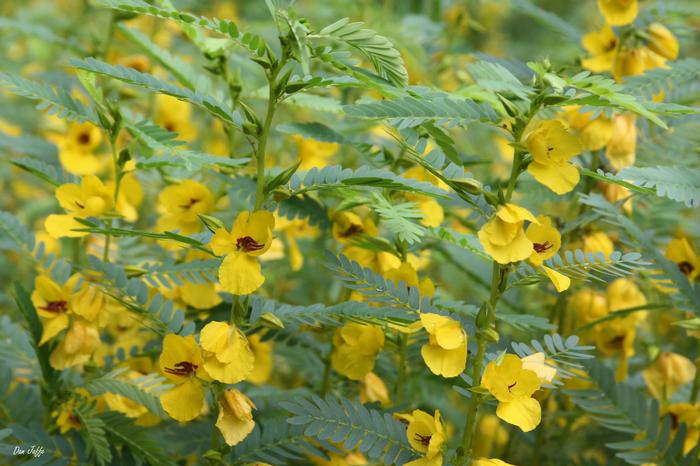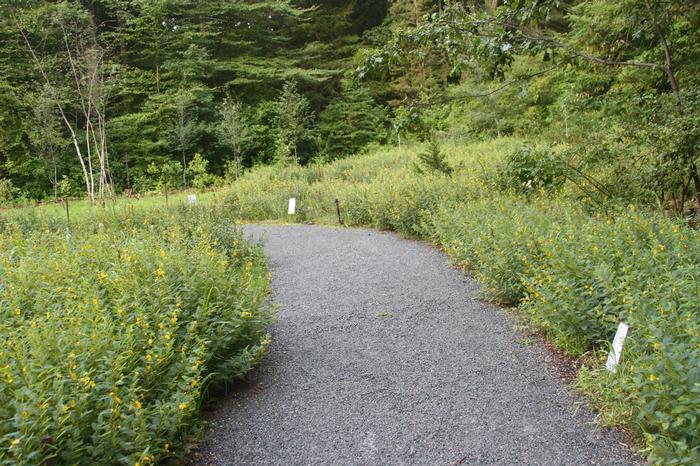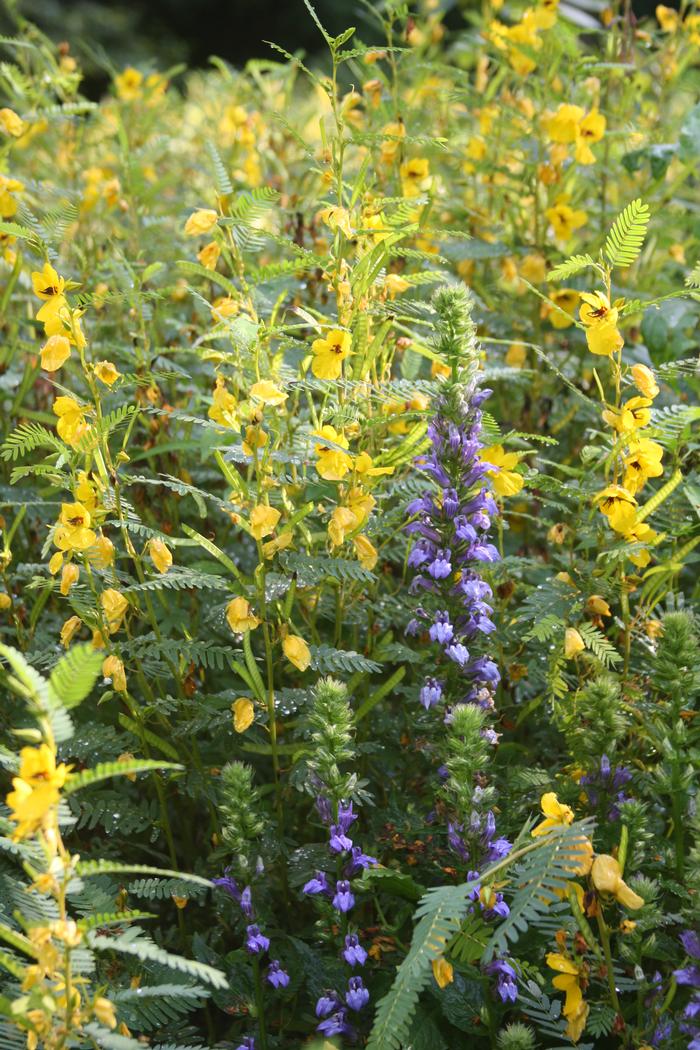General Description
Bloom Description: Showy July blossoms provide pollen but no nectar for pollinators. The pea-like, asymmetrical flowers have yellow petals with a dabbling of red in the center, are about 1" large, and are found in clusters of 2 to 6 out of the upper leaf axils along the stem.
Growth Habit & Shape: This fast-growing flower has strong vertical stems and finey textured, pinnately-compound leaves. The plant can form dense colonies via self-seeding, and functions nicely as a groundcover.
Soil Preferences: This plant does well with a wide variety of soils, and tolerates New England acidity reasonably well, though it has a preference for circumneutral to slightly alkaline soils.
Root Description: This plant puts down a central taproot along with smaller auxiliary roots. In sandy soil, however, this plant is not heavily anchored and fairly easily ripped up. It fixes nitrogen in conjunction with symbiotic bacteria, which conduct their activities in nodules throughout the root system. These nodules serve as a source of nitrogen both for the plant and for the surrounding soil.
Garden Uses: Open sow on roadsides, highway margins, hellstrips, swales, meadows, stream banks, and compact urban gardens, where it will tolerate clay.
Best Management & Maintenance: With no interference, populations will dwindle over several years as longer lived perennials, trees, and shrubs establish. Keep soil disturbed and open to encourage reseeding. This can be done through burning or mowing in late winter or early spring. If mowing, removal of thatch may be required.
Common Problems: Susceptible to mildew and leafspot in areas with poor air circulation, but otherwise relatively disease-free.
Benefits
Ornamental Value: This annual, with its delicately compound leaves and bold yellow and red blooms, can serve as a beautiful, interesting cover crop, lending excellent texture to areas that would otherwise be overrun by weeds.
Wildlife Benefits: Insect interactions with partridge pea are complex, fascinating, and deserve further study. Bees are the primary pollinators of the flowers (which do not provide nectar), especially bees that are adept at buzz pollination like bumblebees and carpenter bees. Ants, butterflies, bees, wasps, and lady-beetles are attracted to the extrafloral nectaries at the base of the petioles, which provide nectar but play no reproductive role. In return for the nectar offered by the nectaries, these insects protect the plant by preying on herbivores such as caterpillars and other insects.
Partridge pea is also a larval host plant for the io moth, gray hairstreak, sleeping orange butterfly, cloudless sulphur, and common tan wave. One study done at the University of Maryland, titled "Partridge Pea: Your Local Community Buffet for Natural Enemies in Organic Corn," suggests it may even act as a trap crop, luring pests like stink bugs and the European corn borer away from corn crops. It also attracts beneficial insects that could help predate corn pests. In addition, partridge pea provides cover for game birds and forage for deer. Per the USDA PLANTS database, the seed is one of the major food items of northern bobwhite and quail during the winter and early spring.
Other Practical/Environmental Benefits: Erosion control and soil stabilization, nitrogen fixation, and cover crop/weed suppression
Use in place of: Securigera varia (purple crown-vetch)
Ecology
Habitat:
In the wild, found in disturbed areas like roadsides, but also abundant in rocky open woods, upland slopes, ridges, bluffs, prairies, grasslands, rocky fields and open thickets.
Response to Disturbance: As an annual, this plant requires soil disturbance and open soil to reseed and perpetuate populations year after year. See garden management section for more detail.
Native State Distributions:
Canada: introduced
USA: AL, AR, CT, DC, DE, FL, GA, IA, IL, IN, KS, KY, LA, MA, MD, MI, MN, MO, MS, NC, NE, NJ, NM, NY, OH, OK, PA, RI, SC, SD, TN, TX, VA, WI, WV
Wetland indicator status: FACU
References
- GoBotany
- NatureServe Canada
- NatureServe. 2020. NatureServe Explorer: An online encyclopedia of life [web application]. Version 7.2. NatureServe, Arlington, Virginia.
- Missouri Botanical Garden Plant Finder Database
- USDA NRCS fact sheet
- Illinois Wildflowers, Dr. John Hilty
- Hunt, Lauren, & Hooks, Cerrutti: Partridge Pea: Your Local Community Buffet for Natural Enemies in Organic Corn. Vegetable and Fruit Headline News Vol. 5, Issue 7. University of Maryland Extension 2014.
- Naisbitt, T., James, E. K., & Sprent, J. I. (1992). The evolutionary significance of the legume genus Chamaecrista, as determined by nodule structure. New Phytologist, 122(3), 487-492.
- Hanna E. Dorman, & Lisa E. Wallace (2019). Diversity of Nitrogen-Fixing Symbionts of Chamaecrista fasciculata (Partridge Pea) Across Variable SoilsSoutheastern Naturalist, 18(1), 147 – 164.
- Anna Fialkoff, Personal Communication
- Leslie Duthie, Personal Communication
Return to Top



